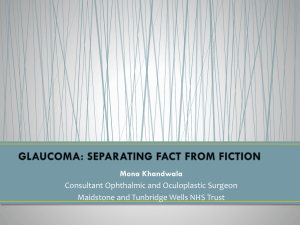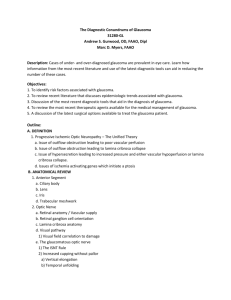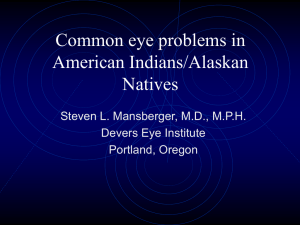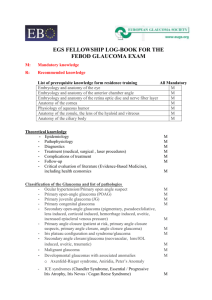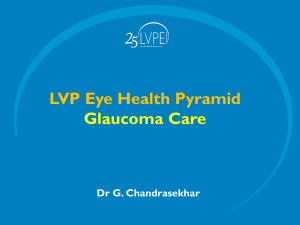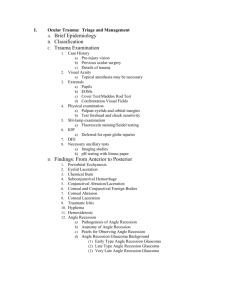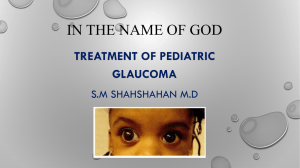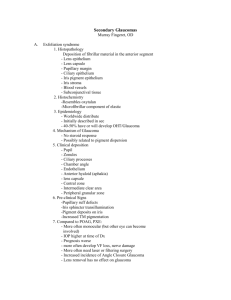File
advertisement
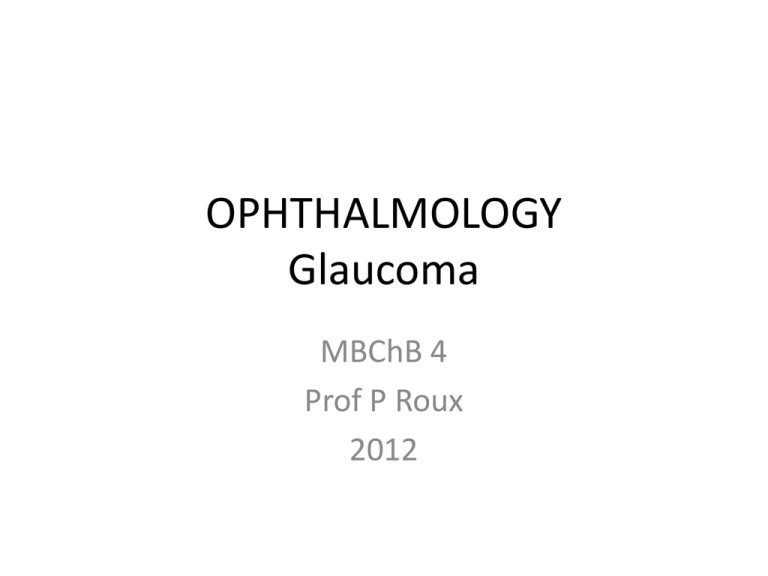
OPHTHALMOLOGY Glaucoma MBChB 4 Prof P Roux 2012 WHAT IS GLAUCOMA? •A GROUP OF DISEASES IN WHICH INTRAOCULAR PRESSURE (IOP) CAUSES DAMAGE TO VISION. COMMON FEATURES: •Optic disc cupping •Visual field loss •Raised intraocular pressure (Usually) AQUEOUS HUMOUR DYNAMICS: PRODUCTION OUTFLOW •SECRETION •ULTRAFILTRATION •TRABECULAR MESHWORK (ANGLE) •UVEOSCLERAL PATHWAY Aqueous outflow Anatomy a - Uveal meshwork b - Corneoscleral meshwork c - Schwalbe line d - Schlemm canal e - Collector channels f - Longitudinal muscle of ciliary body g - Scleral spur Physiology a - Conventional outflow b - Uveoscleral outflow c - Iris outflow CLASSIFICATION: ACCORDING TO: ANGLE ASSOCIATED FACTORS •PRIMARY •OPEN-ANGLE •ANGLE-CLOSURE •SECONDARY AGE OF ONSET •CONGENITAL •INFANTILE •JUVENILE •ADULT ANGLE a b Open-angle a. Pre-trabecular - membrane over trabeculum b. Trabecular - ‘clogging up’ of trabeculum c d Angle-closure c. With pupil block - seclusio pupillae and iris bombé d. Without pupil block - peripheral anterior synechiae ASSOCIATED FACTORS SECONDARY GLAUCOMAS 1. Pseudoexfoliation glaucoma 2. Pigmentary glaucoma 3. Neovascular glaucoma 4. 5. 6. 7. 8. Inflammatory glaucomas Phacolytic glaucoma Post-traumatic angle recession glaucom Iridocorneal endothelial syndrome Glaucoma associated with iridoschisis PATHOGENESIS •INDIRECT ISCHAEMIC THEORY (MICROCIRCULATION/ PERFUSION PRESSURE) •DIRECT MECHANICAL THEORY (DAMAGE TO NERVE FIBRES) Theories of glaucomatous damage Direct damage by pressure Capillary occlusion Interference with axoplasmic flow Risk Factors 1. Age - most cases present after age 65 years 2. Race - more common, earlier onset and more severe in blacks 3. Inheritance • Level of IOP, outflow facility and disc size are inherited • Risk is increased by x2 if parent has POAG • Risk is increased x4 if sibling has POAG 4. Myopia 5. Diabetes EXAMINATION 1. TONOMETRY (PRESSURE) 2. GONIOSCOPY (ANGLE) 3. VISUAL FIELD 4. OPTIC DISC (OPTIC NERVE) Tonometers Goldmann Contact applanation Air-puff Non-contact indentation Perkins Portable contact applanation Pulsair 2000 (Keeler) Portable non-contact applanation Schiotz Contact indentation Tono-Pen Portable contact applanation Goniolenses Goldmann • • • • • Single or triple mirror Contact surface diameter 12 mm Zeiss Four mirror • Contact surface diameter 9 mm Coupling substance required • Coupling substance not required Suitable for ALT • Not suitable for ALT Not suitable for indentation gonioscopy • Suitable for indentation gonioscopy • Indentation gonioscopy Differentiates ‘appositional’ from ‘synechial’ angle closure Press Zeiss lens posteriorly against cornea Aqueous is forced into periphery of anterior chamber Humphrey perimetry Anatomy of retinal nerve fibres Papillomacular bundle Horizontal raphe Optic nerve head Small physiological cup a - Nerve fibre layer a b b - Prelaminar layer c - Laminar layer c Large physiological cup • Normal vertical cup-disc ratio is 0.3 or less • 2% of population have cup-disc ratio > 0.7 • Asymmetry of 0.2 or more is suspicious Total glaucomatous cupping Types of physiological excavation Small dimple central cup Larger and deeper Cup with sloping temporal punched-out central cup wall Pallor and cupping Pallor - maximal area of colour contrast Cupping - bending of small blood vessels crossing disc Cupping and pallor correspond Cupping is greater than pallor TREATMENT OF GLAUCOMA MEDICAL 1 2 SURGERY Trabeculectomy LASER 3 ANTIGLAUCOMA DRUGS 1. ALPHA-2 SELECTIVE ADR. AGONISTS - Alphagan 2. BETA-ADRENERGIC BLOCKING AGENTS - Betagan 3. CARBONIC ANHYDRASE INHIBITORS - Trusopt 4. PROSTAGLANDIN DERIVATIVES - Xalatan 5. PILOCARPINE 6. ADRENALINE DECREASED AH PRODUCTION •ADRENERGIC AGONISTS -ALPHA-2 •ADRENERGIC ANTAGONISTS -BETA BLOCKERS •CAI INCREASED OUTFLOW •ADRENERGIC AGONISTS (NON SELECTIVE) •PILOCARPINE •PROSTAGLANDINE DERIVATIVES ANGLE GLOSURE GLAUCOMA • • • • • ACUTELY PAINFULL RED EYE !! LOSS OF VA , CLOUDY CORNEA, NON REACTIVE PUPIL, LOSS OF RED REFLEX MANAGEMENT • DIAGNOSIS • TOPICAL & SYSTEMIC PRESSURE REDUCTION • PILOCARPINE (REDUCE PUPIL BLOCK) • SYSTEMIC ANALGESIC & ANTI-EMETICS • LASER PI SURGERY: Technique a b a. Cutting of deep block anterior incision b. Posterior incision c d c. Excision of deep block d. Peripheral iridectomy e f e. Suturing of flap and reconstitution of anterior chamber f. Suturing of conjunctiva OPEN ANGLE GLAUCOMA ANGLE CLOSURE SECONDARY GLAUCOMAS Sturge-Weber syndrome Naevus flammeus Meningeal haemangioma Port-wine stain • • Congenital, does not blanche• with pressure Associated with ipsilateral • glaucoma in 30% of cases CT scan showing left parietal haemangioma Complications - mental handicap, epilepsy and hemiparesis Fibroma molluscum in NF-1 Iris melanoma • Usually pigmented nodule at • Occasionally non-pigmented least 3 mm in diameter • Surface vascularization • Invariably in inferior half of iris • Angle involvement may cause• Pupillary distortion, ectropion glaucoma uveae and cataract
